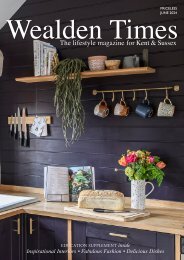Wealden Times | WT264 | May 2024 | Love Your Home Supplement inside
The lifestyle magazine for Kent & Sussex - Inspirational Interiors, Fabulous Fashion, Delicious Dishes
The lifestyle magazine for Kent & Sussex - Inspirational Interiors, Fabulous Fashion, Delicious Dishes
Create successful ePaper yourself
Turn your PDF publications into a flip-book with our unique Google optimized e-Paper software.
ut these are evergreen and it has<br />
the added advantage of handsome<br />
lime coloured bracts in spring.<br />
A useful, if diminutive, group of plants<br />
that seem to grow in any situation,<br />
including tricky dry shade, are the<br />
Heucheras. There is a striking, almost<br />
black variety called ‘Obsidian’, several<br />
cultivars come in opulent maroon shades,<br />
but there are lighter colours too, and for<br />
a splash of orange, try H. ‘Marmalade.’<br />
An Annual Blast<br />
You can’t beat annuals for a long and<br />
colourful season. Their short, but actionpacked<br />
lives are focused on flowering.<br />
Annuals only have one short year in<br />
which to complete their life-cycle. If you<br />
can thwart them in their life’s purpose<br />
by continually dead heading, they will<br />
keep trucking along, flowering until the<br />
frosts. Floriferous and reliable annuals<br />
include Cosmos – usually in shades of<br />
white and pink, but some orange and<br />
yellow varieties too, – Antirrhinums<br />
that bring a rainbow of spires, and<br />
Tithonias and Zinnias that sing out,<br />
acid bright in the sunshine. For the<br />
shadier parts of the garden, use scented<br />
and muted tones of Nicotiana, or low<br />
growing Impatiens (busy lizzies)<br />
Colourful Containers<br />
Annuals and tender bedding plants in<br />
pots will bring instant colour and impact<br />
to key areas – terraces and paving are<br />
the immediate thought, but you can<br />
even put pots into gaps in the borders,<br />
or places where the interest is flagging.<br />
The great thing about bedding plants<br />
is that they flower for a long period.<br />
Remember to look after them – water<br />
containers daily in warm weather and<br />
if you planted them up in late spring<br />
for a summer long show, the multipurpose<br />
compost only has enough<br />
food in it for 6 weeks, so after that<br />
they will need a weekly feed of liquid<br />
seaweed, or a high potash fertiliser.<br />
Pelargonium are a good old stalwart,<br />
but there’s a multitude of container plants<br />
on sale right now at the garden centres –<br />
choose your colour scheme, but also think<br />
about shape. Depending on the size of<br />
the container (and in summer try to use<br />
larger containers as they won’t dry out as<br />
quickly), you will need a tall central plant<br />
– an Antirrhinum majus, a tall tobacco<br />
plant or spire of some kind will work well,<br />
Mauve foxgloves<br />
Pastel tulips<br />
Alchemilla and Geranium<br />
‘Johnsons Blue’<br />
then mid height and with a contrasting<br />
flower shape – large flowered like a<br />
Petunia or Zinnia and then something<br />
to spill over the edges – Nemesia, Diascia<br />
or Lobelia, even ivy. The phrase used in<br />
container gardening circles (I’m guessing<br />
there are such things) is ‘thriller, filler,<br />
spiller’ to remind us of the types of<br />
plants that make good shapes in a pot.<br />
Seasonal Colour<br />
The quality of light changes through the<br />
year – furthest away and weaker in the<br />
winter, blazingly close in the summer.<br />
The seasonal light of the sun will affect<br />
the colour palette of plants too. Pale<br />
winter light favours silhouettes and husky<br />
shapes. Most of the late winter and early<br />
spring flowers are white, yellow or cream<br />
to signal more strongly to pollinators in<br />
low light. Spring is all new and green,<br />
interspersed with fresh blues, yellows<br />
and froths of pink. As the light gets<br />
stronger and the sun rises higher in the<br />
sky, the colours strengthen – to attract<br />
in sun-loving butterflies and bees.<br />
Our cottage garden favourites –<br />
geraniums, lupins, delphiniums and geum<br />
will have finished flowering by July and<br />
can also have quite straggly foliage by that<br />
time too. Keep the June blooms coming<br />
by being ruthless – cut them all back<br />
A raised bed in late summer<br />
– right down to the ground as soon as<br />
they’ve finished flowering and by the end<br />
of August they will be back with a repeat<br />
show of flowers and tidy new leaves.<br />
During late summer and early autumn<br />
the palette changes again as the light<br />
softens and sinks lower in the sky.<br />
Bring in Heleniums and Rudbeckias in<br />
russet, gold and mellow orange, the<br />
deep blue of Echinops and brighter hue<br />
of Ceratostigmas, Salvias in a myriad of<br />
colours and the dusky pinks and mauves<br />
of Asters. The flowers of Sedum spectabile<br />
are a magnet for butterflies and bees and<br />
are a great addition to the front of the<br />
border, providing long lasting colour right<br />
through the autumn too, as the nectarpacked<br />
flowers fade into attractive seed<br />
heads in shades of russet and bronze.<br />
Every season brings in a range of<br />
different colour choices – I once gave each<br />
month a colour (but we know that way<br />
madness lies). In the end it will always<br />
be down to personal preference – the<br />
important thing is to enjoy the colours<br />
of your garden, calm harmony or riotous<br />
assembly – it’s entirely up to you.<br />
Join Jo for a gardening class at her<br />
garden in Woodchurch. Call 07923<br />
969634 or see hornbrookmanor.co.uk.<br />
priceless-magazines.com<br />
110

















